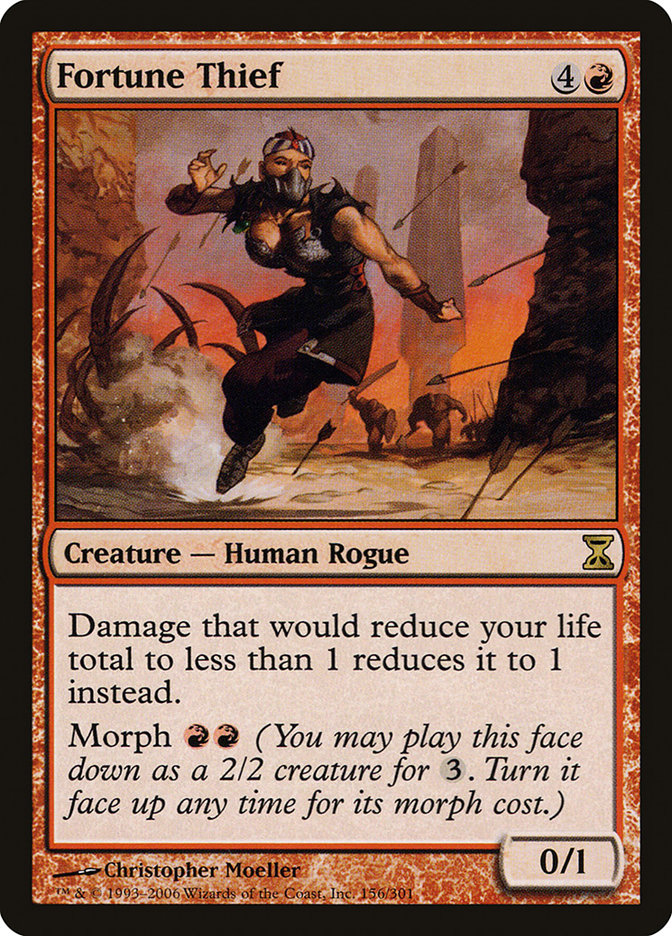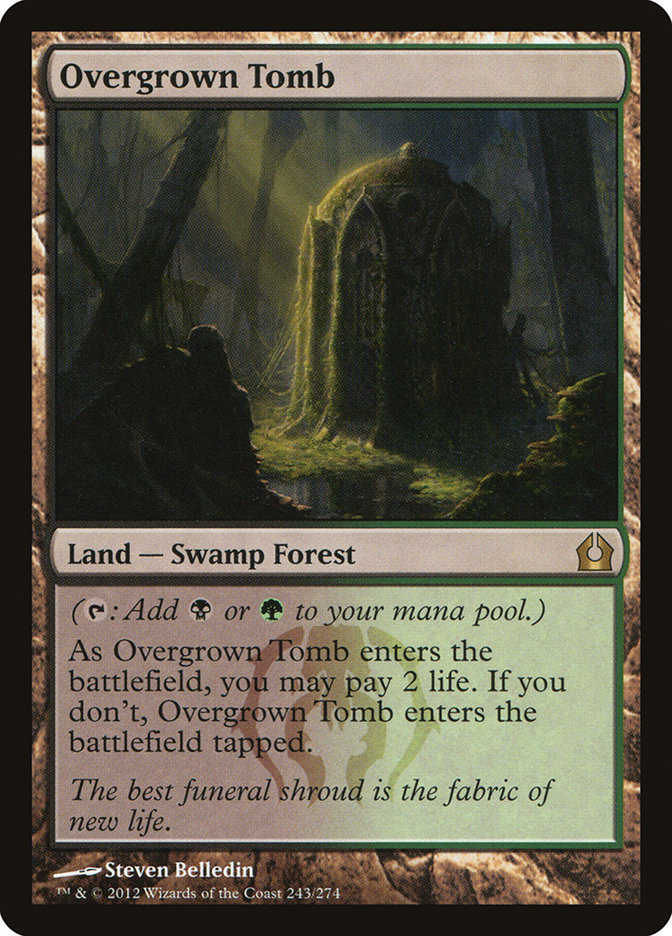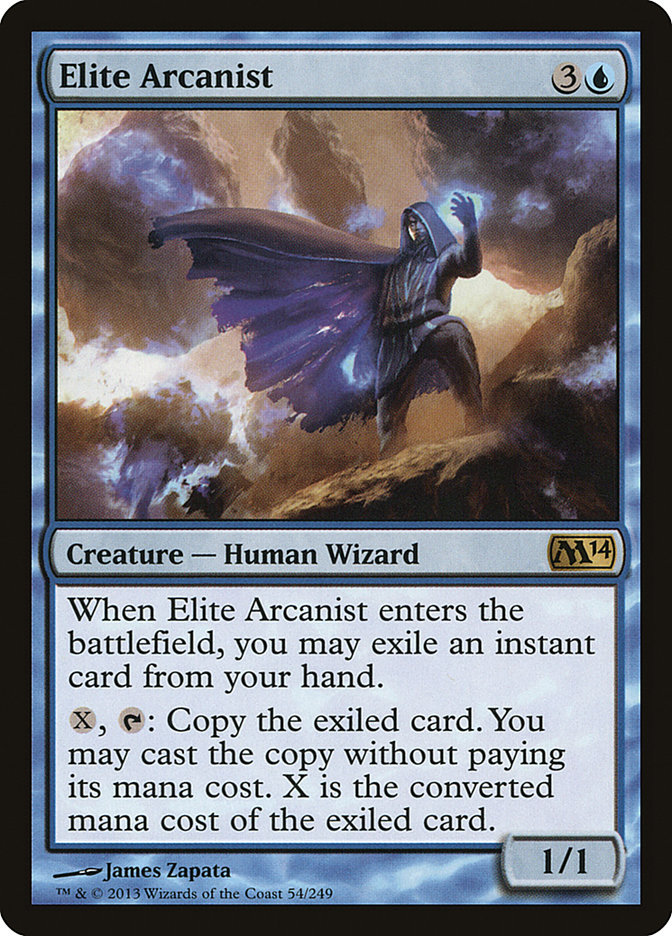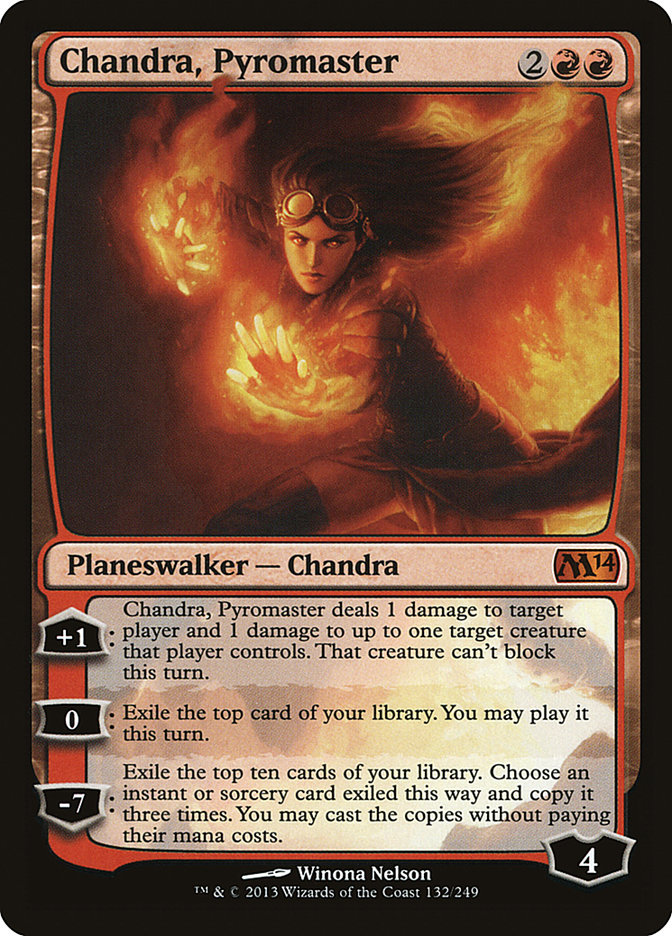Round 7: Douglass with G/W Glare
Game 1
He has a wicked start with Vinelasher Kudzus and multiple Terramorphic Expanses and puts me to four. I have the Wrath just in time. Of course, I miss more Firemane points, but the card advantage is enough. I buy a little time and end this one on 28.
Game 2
We play attrition early, and I hit Fortune Thief. Graciously, Douglass concedes. He has Serrated Arrows, but seeing only Firemane Angel in game 1, he left them in the board.
6-1
[from Winner Winner Chicken Dinner]
That’s what I wrote at the time.
Seven itchy years later, it fails to convey the tumbling combination of gamble, uncertainty, and inevitability I was feeling in the moment. We had prepared disproportionately for a tournament with a six-inch plaque as its only reward, worked from a differing paradigm from the common beatdown-combo-control trio that dominates most format generalizations to beatdown-beatdown destroyer-beatdown destroyer destroyer. Beatdown was the default: your Boros, your Zoo.
We largely rejected the idea of control decks; there were all different kinds of decks to try to answer, and permission was performing erratically. Too many headaches; not enough payoff. Instead we focused on beatdown destroyers: over the top against beatdown. Contain while countering (Lightning Angel); leveled value trading (Lightning Helix); good old card advantage (Wrath of God)… But no illusions. Beatdown destroyers did one thing well: you could devote a small portion of your beatdown destroyer to inevitability against control [which, again, we considered pointless ourselves].
The problem was beatdown destroyer destroyers. Beatdown destroyer destroyer is an interesting subarchetype; they actually tended to beat both beatdown and beatdown destroyer decks. Small formats can be weird; Deck One beats all decks but Deck Three; Deck Two beats all decks but Deck One; Deck Three draws with Deck Four but outright crushes Deck One. Traditional beatdown-combo-control labeling is even less useful than usual, with a handful of differently enabled blue sub-archetypes going for disparate routes to inevitability in an orgy of "Who’s The…" question marks.
So… Back to Fortune Thief.
My Brian Kowal’s beatdown destroyer had two big fat holes in its matchups. You could never cleanly beat a combo deck, at least not with your main, but combo decks were rarer than viable dragon eggs before Khaleesi’s wedding. You were more saliently way behind against a legit beatdown destroyer destroyer. Draw all the cards you want, gain all the life you want, at the end of the day they were tapping your guys. All your guys. They had more than enough fuel, and you couldn’t really stop them short of killing them. They’d deck you half the time. Humiliating.
Fortune Thief had one job, like Samwell Tarly. ONE JOB! Get in play against Ghazi-Glare; don’t die for about 40 turns. Eventually you were meant to deck ’em with a ‘Research. Lots of gambol to this. One: some Glare players splashed for Thornscape Battlemage starting. Your strategy can’t be both "keep this 1/1 in play for 40 turns" and "hope they don’t draw their out" [provided they have an out]. You needed to wager they didn’t have a damn out. Game theory! If there are no legit targets for Thornscape Battlemage, maybe, hopefully, they’ll side him out. Secondly, you can’t really do it twice. Even if you get them and have the actual clock time to deck them again in game 3, you have to assume they have one Serrated Arrows somewhere in their 75. One Arrows—which they are certain to find—kills all three Ali From Cairos.
Gamble. Uncertainly. Inevitability. Elation.
Then… It’s over.
Game 1—so much work. But game 2? Pull this off (just draw your Morph) and it is supposed to be easy. Jump through the right hoop theoretically: you can’t lose.
One of you has inevitability. Either they can’t beat it or they have a card in their deck and you are giving them time to find it. No other real possibility. I think people on the other side make the mistake of trying to hurry to their out-out. You don’t have to hurry in these situations. The "trump card" guy is playing to give you time. When you and your buddy are in the forest getting chased by a bear, you don’t have to be faster than the bear, only faster than your buddy.
Pulled it off!
Pulled it off. Seems like a small thing; if Douglass hadn’t run the give ups, I would have still had to execute on Compulsive Research… Lots of stuff still could have gone awry. But I didn’t have to; Fortune Thief-Ali-Tarly did his one job. Game 1 was hard, but game 2 actually locked me for Top 8. Elation.
My working theory for the roughly the past twenty has always been that the addictive nature of Magic is tied to the infinite horizons of deck design. New sets constantly give possibility to new possibilities. Ergo, there is a never-ending series of new ideas. For me, the apex of elite deck design is not necessarily having the most inventive idea; it’s in differentiated decisions when all parties have reasonable if not limitless access to information.
Other people might have a U/R/W Angel deck, but did they puzzle through the ability to deck Glare? It’s the same reason I have always been so high on Gnarled Mass… Jitte/Legends was a known strategy, powerful but saddled with a specific set of vulnerabilities. Figuring out one seemingly low-power card was what elevated the strategy past predictable competitors. Such discoveries are uncommon, which is what makes them so special. Given enough format length, they even become stock. The best recent example is this:
Bant decks were a known quantity. What made the Cuneo-Black-REID DUKE deck so special was uncovering the synergy between Overgrown Tomb and Farseek. The cost now… So low. Like Fortune Thief, Overgrown Tomb had one job (though it ended up doing more). Thragtusk et al. were for the normal / predictable tasks; Tomb [powering Nephalia Drownyard] gave the deck an inevitable threat against other control then ended up one of the most common ways to win in general.
Today Brainstorm is AJ Sacher favorite card, a given in Legacy, but there was a time when it was not at all popular. Brainstorm did not even make the cut in the initial Xerox lists! Who knows how long Brainstorm would have taken to cement without innovators like Andrew Cuneo combining it with Thawing Glaciers. Electrostatic Bolt was not initially played in Affinity; however, when Affinity rose to become the most popular deck in Standard and Block, players like Mike Clair and Jeff Garza used Electrostatic Bolt as a catchall to stop both Disciple of the Vault and Arcbound Ravager… That could conveniently snipe a Slith Firewalker or Goblin Warchief. Mortarpod in Caw-Blade. Lingering Souls in Legacy Stoneblade. To me, these discoveries, enriching and further enabling existing archetypes, are the pinnacle of deck design excitement.
Perhaps I am in the minority, but these are the kinds of thoughts I have when looking at this piece:
I see this, and I think about lying on the beach in Waikiki. Surf is hitting, breeze blowing; it’s hot, but as long as I don’t burn, I have not a care in the world.
Stick Elite Arcanist correctly in the right spot in the right matchup… And it’s over, just like Fortune Thief.
There are simply tons of decks in Standard that can’t easily remove a 1/1. Some have removal, but it is corner stuff like Abrupt Decay or Selesnya Charm—extant but not appropriate. Consider for a moment the sideboard of a Fog variant against a Blitz deck. Game 1 might be a challenge, but afterward you can set yourself up for a freebie. Maybe turn 5 with G open and a Fog in grip? Safe Passage might be the best to "imprint" because you can potentially protect Elite Arcanist itself from potential burn cards. Really, the goal is to buy time to build your other advantages and stockpile value in your various cards, life, mana development, et al. buckets while the opponent either commits more and more or attempts to hurry to an out.
You don’t actually need Elite Arcanist to win… It just does a tremendous amount of work as the opponent does need it to be removed in order to avoid losing. I think one amazing avenue is simply to get two into play. One on Riot Control and one on Safe Passage? Standard at the present has got a lot of soft matchups for this creature; many decks—ill-advised sideboarding or no—are just never going to beat two.
Fog is not the end of strategy. Elite Arcanist is a Human Wizard! If you are already playing Cavern of Souls in your U/R/W Aetherling deck like I am [oldarticlelink id="26296"]Rah-Rah Raka Tapout[/oldarticlelink], Elite Arcanist can line up the value without compromising what you were going to set up for Tiago anyway. While it may be unrealistic in the mirror (too many Pillars, Spears, Helixes, et al. for the opponent to conceivably side out), there are many control variants that are going to pull their pants down just far enough to make this creature very good, if not inevitable. Resolve? Thought so. Let’s see how long you can live with an Azorius Charm every turn. Repeated Azorius Charm incidentally can contain an Aetherling.
I’ll concede that Elite Arcanist doesn’t have the look of a format-breaking creature in 2013. It is a 1/1 for four mana that asks you to give up an extra card and wait a turn—and devote operating mana on a continual basis—in order to do anything. But all of that together is what makes it such a compelling case for Next Level deckbuilding. Nobody said this would be easy. Get it right, though, and it feels pretty wonderful.
Switching gears to another four that has gotten decidedly more press, the latest in Chandra-branded planeswalker technology, Chandra, Pyromaster:
To date, 36 different planeswalker cards have seen print, with Garruk, the Veil-Cursed arguably making for 37 separate planeswalker iterations. Of the 36, a stunning percentage have been tournament viable, probably more than any other card type. Oddballs like Sorin Markov have contributed in decks as far afield as Grixis Control, Junk Midrange, and Martyr of Sands. Karn Liberated has been the target endgame for Modern decks, and Nicol Bolas, Planeswalker has stood in for Cruel Ultimatum in formats as wide and competitive as Extended.
Of course, the glamour jobs have gone primarily to the four-mana planeswalkers: World Champion Ajani Vengeant; Pro Tour Champion Elspeth, Knight-Errant; and perhaps the greatest of them all, Jace, the Mind Sculptor.
All of this together has made for some frustrating positioning for one Ms. Nalaar.
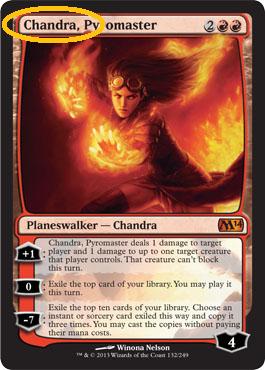
There have been three Chandra variants prior to Chandra, Pyromaster and none of them has been particularly popular or successful. In contrast, all three versions of Liliana have seen play, and Liliana of the Veil contends for the title of second-best planeswalker of all time. There have been three-point-five Garruks before newcomer Garruk, Caller of Beasts; all three are cross-format performers, and the crappiest of them is a PT Champion!
It seems that WotC R&D are doing everything in their power to power up this version of Chandra, including not just a Felicia Day YouTube video and planeswalker promotion but getting the casting cost right:
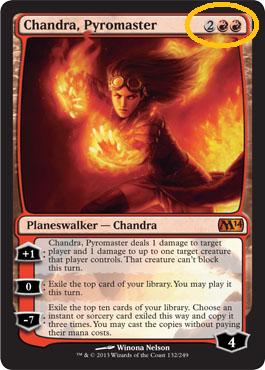
As we said before, most of the strongest contending planeswalkers have been four casters, so all other text unseen the top-right number is a promising indicator.
Of course, WotC tried this with Chandra, the Firebrand but was not successful in making a Chandra that latched on to the hearts and minds of the player base as a whole or even a couple of spike bullets. A key difference between Chandra M14 and Chandra M13 is that the new model is far less splashable. Chandra, the Firebrand cost 3R, making her a more viable Super Friends splash (which of course never happened). Chandra, Pyromaster might not be Koth of the Hammer… But she is fundamentally less friendly to U/x multicolor battlefield control strategies.
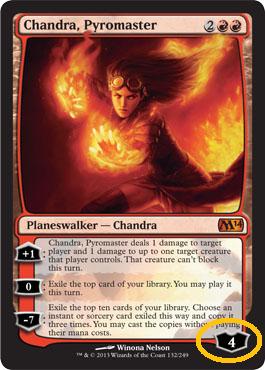
On balance, Chandra, Pyromaster has an almost unprecedented level of starting loyalty. Four! This loyalty is a point up from Chandra, the Firebrand and in fact is the equivalent to the starting loyalty of five-mana planeswalkers like Tamiyo, the Moon Sage and Tezzeret the Seeker. This upgrade would seem cosmetic in isolation (Ajani Vengeant has loyalty three and is much stronger than co-four-mana Ajani, Ajani Goldmane; the same is true of Jace, the Mind Sculptor over Jace, Architect of Thought at four), but…
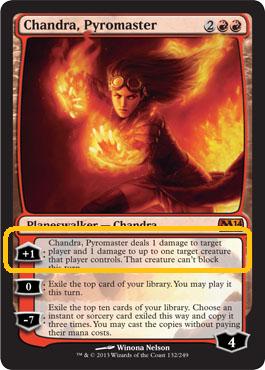
Chandra M14 also essentially doubles the efficacy of Chandra M13’s [+1] ability. To be perfectly clear, the old version did one point; the new version deals up to two points (one and one) and can keep a potentially troublesome creature from blocking. This is just a spectacular upgrade, especially for attack decks.
The most successful red planeswalker to date has been Koth of the Hammer (also a four-drop). Koth lacked the ability to protect himself but could contribute to aggressive decks by hitting opponents. Chandra, Pyromancer can contribute to aggressive decks by enabling other creatures to hit, though like Koth she can win the game by herself (conceivably). As a bonus, she does so outside the red zone.
Koth’s other big area of contribution was as a sideboard card or extra threat option for U/R Control or U/R Combo decks. Chandra can fill the same role by giving you a way to win besides Plan A. Though she doesn’t have Koth’s explosive mana ability, Chandra can contribute via pure card advantage:
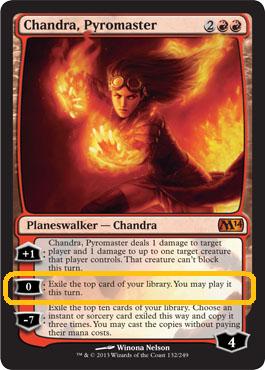
I feel like the aesthetics of this ability are a direct challenge to Jace, the Mind Sculptor… +1 card advantage for [0] loyalty. How else are we supposed to read this? This is purely a +1 card advantage option. Make sure you use it before you play your land for the turn unless you have a really good reason. Obviously you can be bound by mana, but a lot of that is fixable in the tuning stage (i.e., prior to the execution stage).
It probably goes without saying that this ability is a bit less flexible than a straight "[0] Draw a card[.]" or certainly Jace, the Mind Sculptor’s Brainstorm ability. For instance, you are not going to want to play your fourth land and immediately [0] very often (while that was a fairly common sequence with Jace). So from a flexibility standpoint, you are going to generally [+1] Chandra first turn around unless you topdeck her deep with plenty of lands in play (and even then you will want to wait on playing a land in case one is on top of your deck). Again, Chandra is going to reward players who build their decks with her in mind; a deck planning to [0] on turn 5 is going to get lower returns if it plays with a lot of fives and sixes.
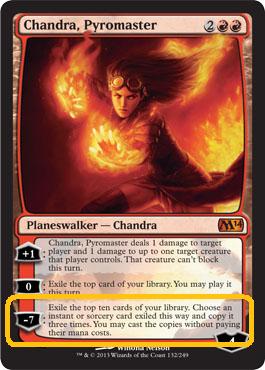
Chandra, Pyromaster’s ultimate is honestly a bit weak if still contextually game winning. I read this as being "deal nine" as a mode, but that is obviously a gross and perhaps premature generalization. Chandra, Pyromaster requires a bit of thoughtfulness in deck design… Clearly there are synergies for attack decks and possibilities for control decks. If you want to take advantage of [+1,] you probably should have attackers, [0] asks you to temper your CMCs, and if you want to break [-7], you need to have some decent instants and sorceries to copy.
Not brain surgery (like making Elite Arcanist rev up Standard maybe), but not trivial either.
I find the new Chandra substantially more compelling than the new Garruk, but to borrow from my friend Patrick Chapin, "Chandra, Pyromaster will appear in the Top 8 of Standard tournament decks."
LOVE
MIKE

